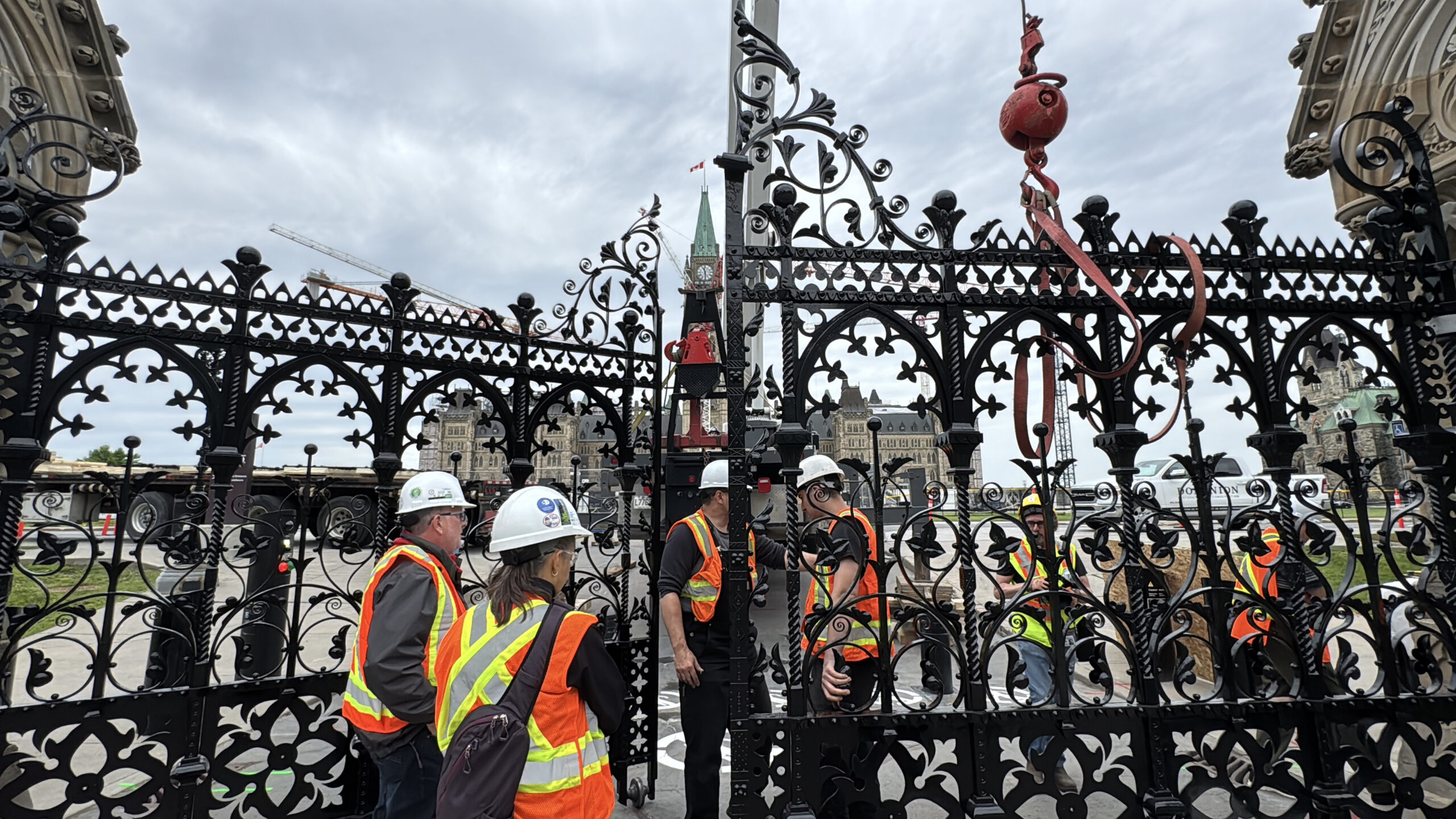Gatekeepers: Restoring Parliament Hill’s heritage Queen’s Gates
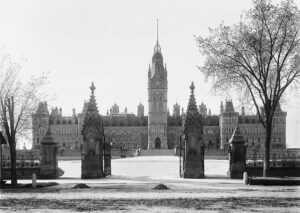
The wrought iron Queen’s Gates are one of Parliament Hill’s oldest features. Installed in 1876, they are shown in this archival image taken by Alexander W. Galbraith in 1900 in front of the original Parliament Building, which was destroyed in a 1916 fire. | Photo credit: City of Toronto Archives, Fonds 1568, Item 208
A pair of iron gates on Wellington Street have served as the main ceremonial entrance to the Parliament Hill grounds for nearly 150 years. Grand and ornate, imposing yet intricate, they’re known as the Queen’s Gates in honour of Queen Victoria, the long-reigning 19th-century British monarch who wore the crown when Canada became a nation.
Now they’re ready for the next 150 years after restoration.
“They have high cultural, heritage and architectural significance, and they’re works of art,” said Rebecca Casagrande, a conservation materials specialist with Public Services and Procurement Canada (PSPC).
“It’s important for PSPC to conserve these gates for generations to come.”
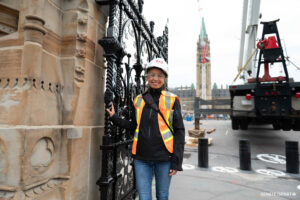
Rebecca Casagrande, a conservation technologist advisor at Public Services and Procurement Canada, said it’s important to preserve Parliament’s Queen’s Gates because of their “high cultural, heritage and architectural significance.” | Photo credit: Senate of Canada
Designed in the High Victorian Gothic style by Canadian architect Frederick J. Alexander, manufactured in Montréal by H.R. Ives and Company in 1872 and installed in 1876, the Queen’s Gates predate the Hill’s most recognizable landmarks: Centre Block, the Peace Tower and the Centennial Flame.
Their impressive longevity can be attributed to the materials from which they were forged: a mix of cast iron and high-quality, wrought iron from the United Kingdom.
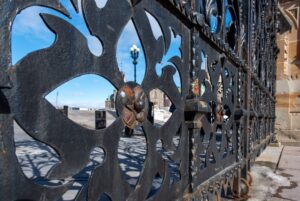
Exposure to the elements and road salts over time led to the deterioration seen here on the Queen’s Gates before restoration began. | Photo credit: Public Services and Procurement Canada
“At the time, they were considered the best example of iron working in North America,” said Ms. Casagrande, who provided technical advice and guidance to the restoration project team.
Removal
The main central gates and the two smaller pedestrian gates on either side were removed from the Wellington Street wall in March 2024.
Because of their substantial weight — the main gates alone weigh the equivalent of an adult black rhinoceros — a mobile crane was brought in to do the lifting and loading.
Once secured onto trucks, the gates were transported to Dominion Restoration’s workshop on Montréal’s South Shore. The Canadian company, which specializes in heritage material restoration, won the competition to restore them.
Restoration
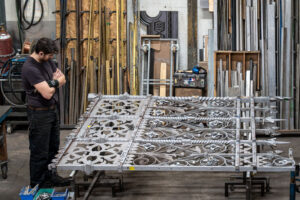
A heritage metal restoration professional inspects part of the main Queen’s Gates at Dominion Restoration’s Montréal workshop. | Photo credit: Public Services and Procurement Canada
While each gate appears to be one big fixture, each leaf is actually made up of approximately 300 separate components. Each rail, each plate, each decorative element — including leaves, flowers and scrolls — is its own work of art.

Every rail, plate and decorative element of the Queen’s Gates — like this flower — is a separate piece and its own work of art. | Photo credit: Public Services and Procurement Canada
Mark Jones, president of Dominion Restoration, said that his team came across a surprise that confirmed the superior quality of the wrought iron they were handling.
“We found a manufacturer’s stamp that said ‘best boiler,’ so we know the material selection for this was really top-notch,” Mr. Jones said.
“When we talk about the grade of wrought iron, boiler or boat chain were the best grades you could get because they were tested. Back in the day, that meant the material was suitable for building a boiler or pressure vessel, and strong enough to hold a boat.”
Over the course of the 20th century, the commercial production of wrought iron declined and ceased altogether with the advent of mild steel, which was cheaper and easier to mass-produce. Mr. Jones sourced recycled, genuine wrought iron from one of the world’s only remaining suppliers.
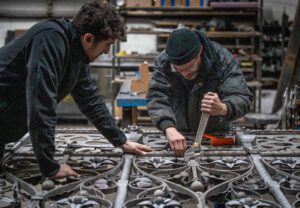
Two heritage metal restoration professionals reassemble a gate in Dominion Restoration’s workshop. | Photo credit: Public Services and Procurement Canada
To begin the restoration, Dominion’s team stripped the outer layer of corrosion and old paint coatings. Next, the parts were soaked in a phosphoric acid bath to transform any hidden rust into iron phosphate that could be brushed away.
Each gate was then reassembled, coated with a zinc primer, wiped with a thinner to protect the newly cleaned iron and prevent rust, and repainted.
Reinstallation
Restored to their original splendour, the Queen’s Gates were transported back to Ottawa and reinstalled in June 2025.
Mr. Jones, who comes from generations of builders, said it was an “honour” to restore what he considers Canada’s most important heritage iron asset, and he’s proud of the work his team delivered.

Dominion Restoration President Mark Jones assists with the reinstallation of the Queen’s Gates on Parliament Hill in June 2025, after his team restored them. | Photo credit: Senate of Canada
“I feel you have to pay homage to the piece and to the artisans,” Mr. Jones said. “As hard as we worked on it, back then, they didn’t have half the tools we have. The gates were all handmade, done at a fire, at a forge, with a hammer and an anvil.”
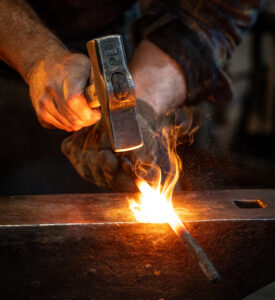
An iron rod is shaped as part of the restoration of Parliament’s heritage Queen’s Gates. | Photo credit: Public Services and Procurement Canada
This article was published on SenCA+, the Senate of Canada’s digital magazine, on September 8, 2025.
In February 2019, the Senate moved to the Senate of Canada Building, a former train station built in 1912. The Senate will occupy this temporary location while Parliament’s Centre Block — the Senate’s permanent home — is rehabilitated.
Although Centre Block is shuttered for rehabilitation work, Canadians can still experience its art and architecture through the Senate’s immersive virtual tour.

